Analysis of AgFeed Industries Inc.'s Foreign Expansion and Setbacks
VerifiedAdded on 2023/01/16
|11
|3882
|89
Case Study
AI Summary
This case study examines the challenges faced by AgFeed Industries Inc., a Chinese company seeking growth through the US capital market. The company initially aimed to access capital by listing on NASDAQ via a reverse merger. However, AgFeed encountered numerous obstacles, including legal issues, financial weakening due to the 2008 economic downturn, and organizational challenges stemming from cultural differences between Chinese and American management. The company's attempt at vertical integration through the acquisition of M2P2 also faced leadership and legal hurdles, including fraudulent activities and financial statement manipulation. The case highlights the importance of corporate governance, ethical business practices, and the impact of economic and regulatory environments on a company's global expansion strategies. AgFeed's experience serves as a cautionary tale for fast-growing companies, illustrating the potential pitfalls of cross-cultural management, capital market regulations, and maintaining investor trust. The company's financial statements show its weakening position, and the case concludes with an analysis of the factors that led to AgFeed's reversal of fortune.

Running head: FOREIGN EXPANSION
Foreign Expansion
Name of the Student:
Name of the University:
Author Note:
Foreign Expansion
Name of the Student:
Name of the University:
Author Note:
Paraphrase This Document
Need a fresh take? Get an instant paraphrase of this document with our AI Paraphraser

1
FOREIGN EXPANSION
Answer 1.
AgFeed faced several problems seeking global financial capital which had serious
impacts on the company. Agfeed was a Chinese private firm which produced food for cattle
namely, pigs and sold pigs for pork. The company operated in the Chinese market of animal feed
and pork and earned high profits owing to the high demand of pork in the country. The listing
procedure of the government of China was extremely complicated which made it tough for the
private limited companies based in China to gain listing on the Chinese stock exchanges. The
government of China imposed quota on the initial public offerings the public limited companies
listed in China could make in the Chinese stock market. The entire procedure of listing took
several years which increased on the listing expenses the Chinese private limited companies had
to incur. Moreover, the foreign investors did not have sufficient access to the Chinese stock
market. This deprived the Chinese listed companies of the global capital. The Chinese companies
had to rely solely on the Chinese market which restricted their capital acquisition and consequent
growth. AgFeed in order to gain access to market capital, acquired shares of an inactive
American public limited company to get access to the American stock market using the process
of reverse merger. As shown several foreign companies get listed on top American stock
exchanges like NYSE and NASDAQ to get access to the American stock market.
Figure 1. Statistics showing foreign companeis listed on NYSE (China is included in Asia)
(Source: Nyse.com, 2019)
AgFeed got listed on the prestigious NASDAQ, one of the world’s leading stock
exchanges which allowed it to harness the booming stock market of the US.
FOREIGN EXPANSION
Answer 1.
AgFeed faced several problems seeking global financial capital which had serious
impacts on the company. Agfeed was a Chinese private firm which produced food for cattle
namely, pigs and sold pigs for pork. The company operated in the Chinese market of animal feed
and pork and earned high profits owing to the high demand of pork in the country. The listing
procedure of the government of China was extremely complicated which made it tough for the
private limited companies based in China to gain listing on the Chinese stock exchanges. The
government of China imposed quota on the initial public offerings the public limited companies
listed in China could make in the Chinese stock market. The entire procedure of listing took
several years which increased on the listing expenses the Chinese private limited companies had
to incur. Moreover, the foreign investors did not have sufficient access to the Chinese stock
market. This deprived the Chinese listed companies of the global capital. The Chinese companies
had to rely solely on the Chinese market which restricted their capital acquisition and consequent
growth. AgFeed in order to gain access to market capital, acquired shares of an inactive
American public limited company to get access to the American stock market using the process
of reverse merger. As shown several foreign companies get listed on top American stock
exchanges like NYSE and NASDAQ to get access to the American stock market.
Figure 1. Statistics showing foreign companeis listed on NYSE (China is included in Asia)
(Source: Nyse.com, 2019)
AgFeed got listed on the prestigious NASDAQ, one of the world’s leading stock
exchanges which allowed it to harness the booming stock market of the US.
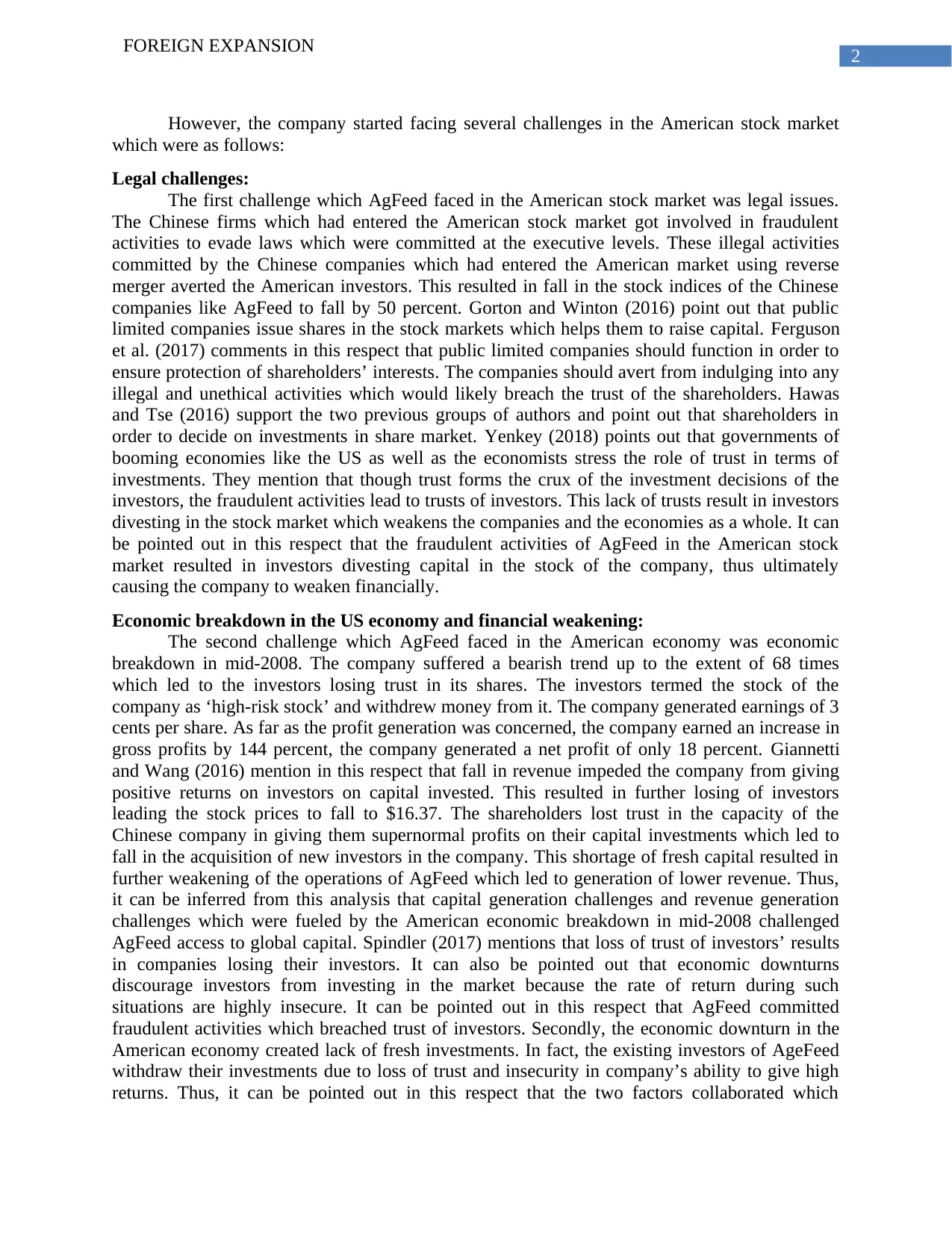
2
FOREIGN EXPANSION
However, the company started facing several challenges in the American stock market
which were as follows:
Legal challenges:
The first challenge which AgFeed faced in the American stock market was legal issues.
The Chinese firms which had entered the American stock market got involved in fraudulent
activities to evade laws which were committed at the executive levels. These illegal activities
committed by the Chinese companies which had entered the American market using reverse
merger averted the American investors. This resulted in fall in the stock indices of the Chinese
companies like AgFeed to fall by 50 percent. Gorton and Winton (2016) point out that public
limited companies issue shares in the stock markets which helps them to raise capital. Ferguson
et al. (2017) comments in this respect that public limited companies should function in order to
ensure protection of shareholders’ interests. The companies should avert from indulging into any
illegal and unethical activities which would likely breach the trust of the shareholders. Hawas
and Tse (2016) support the two previous groups of authors and point out that shareholders in
order to decide on investments in share market. Yenkey (2018) points out that governments of
booming economies like the US as well as the economists stress the role of trust in terms of
investments. They mention that though trust forms the crux of the investment decisions of the
investors, the fraudulent activities lead to trusts of investors. This lack of trusts result in investors
divesting in the stock market which weakens the companies and the economies as a whole. It can
be pointed out in this respect that the fraudulent activities of AgFeed in the American stock
market resulted in investors divesting capital in the stock of the company, thus ultimately
causing the company to weaken financially.
Economic breakdown in the US economy and financial weakening:
The second challenge which AgFeed faced in the American economy was economic
breakdown in mid-2008. The company suffered a bearish trend up to the extent of 68 times
which led to the investors losing trust in its shares. The investors termed the stock of the
company as ‘high-risk stock’ and withdrew money from it. The company generated earnings of 3
cents per share. As far as the profit generation was concerned, the company earned an increase in
gross profits by 144 percent, the company generated a net profit of only 18 percent. Giannetti
and Wang (2016) mention in this respect that fall in revenue impeded the company from giving
positive returns on investors on capital invested. This resulted in further losing of investors
leading the stock prices to fall to $16.37. The shareholders lost trust in the capacity of the
Chinese company in giving them supernormal profits on their capital investments which led to
fall in the acquisition of new investors in the company. This shortage of fresh capital resulted in
further weakening of the operations of AgFeed which led to generation of lower revenue. Thus,
it can be inferred from this analysis that capital generation challenges and revenue generation
challenges which were fueled by the American economic breakdown in mid-2008 challenged
AgFeed access to global capital. Spindler (2017) mentions that loss of trust of investors’ results
in companies losing their investors. It can also be pointed out that economic downturns
discourage investors from investing in the market because the rate of return during such
situations are highly insecure. It can be pointed out in this respect that AgFeed committed
fraudulent activities which breached trust of investors. Secondly, the economic downturn in the
American economy created lack of fresh investments. In fact, the existing investors of AgeFeed
withdraw their investments due to loss of trust and insecurity in company’s ability to give high
returns. Thus, it can be pointed out in this respect that the two factors collaborated which
FOREIGN EXPANSION
However, the company started facing several challenges in the American stock market
which were as follows:
Legal challenges:
The first challenge which AgFeed faced in the American stock market was legal issues.
The Chinese firms which had entered the American stock market got involved in fraudulent
activities to evade laws which were committed at the executive levels. These illegal activities
committed by the Chinese companies which had entered the American market using reverse
merger averted the American investors. This resulted in fall in the stock indices of the Chinese
companies like AgFeed to fall by 50 percent. Gorton and Winton (2016) point out that public
limited companies issue shares in the stock markets which helps them to raise capital. Ferguson
et al. (2017) comments in this respect that public limited companies should function in order to
ensure protection of shareholders’ interests. The companies should avert from indulging into any
illegal and unethical activities which would likely breach the trust of the shareholders. Hawas
and Tse (2016) support the two previous groups of authors and point out that shareholders in
order to decide on investments in share market. Yenkey (2018) points out that governments of
booming economies like the US as well as the economists stress the role of trust in terms of
investments. They mention that though trust forms the crux of the investment decisions of the
investors, the fraudulent activities lead to trusts of investors. This lack of trusts result in investors
divesting in the stock market which weakens the companies and the economies as a whole. It can
be pointed out in this respect that the fraudulent activities of AgFeed in the American stock
market resulted in investors divesting capital in the stock of the company, thus ultimately
causing the company to weaken financially.
Economic breakdown in the US economy and financial weakening:
The second challenge which AgFeed faced in the American economy was economic
breakdown in mid-2008. The company suffered a bearish trend up to the extent of 68 times
which led to the investors losing trust in its shares. The investors termed the stock of the
company as ‘high-risk stock’ and withdrew money from it. The company generated earnings of 3
cents per share. As far as the profit generation was concerned, the company earned an increase in
gross profits by 144 percent, the company generated a net profit of only 18 percent. Giannetti
and Wang (2016) mention in this respect that fall in revenue impeded the company from giving
positive returns on investors on capital invested. This resulted in further losing of investors
leading the stock prices to fall to $16.37. The shareholders lost trust in the capacity of the
Chinese company in giving them supernormal profits on their capital investments which led to
fall in the acquisition of new investors in the company. This shortage of fresh capital resulted in
further weakening of the operations of AgFeed which led to generation of lower revenue. Thus,
it can be inferred from this analysis that capital generation challenges and revenue generation
challenges which were fueled by the American economic breakdown in mid-2008 challenged
AgFeed access to global capital. Spindler (2017) mentions that loss of trust of investors’ results
in companies losing their investors. It can also be pointed out that economic downturns
discourage investors from investing in the market because the rate of return during such
situations are highly insecure. It can be pointed out in this respect that AgFeed committed
fraudulent activities which breached trust of investors. Secondly, the economic downturn in the
American economy created lack of fresh investments. In fact, the existing investors of AgeFeed
withdraw their investments due to loss of trust and insecurity in company’s ability to give high
returns. Thus, it can be pointed out in this respect that the two factors collaborated which
⊘ This is a preview!⊘
Do you want full access?
Subscribe today to unlock all pages.

Trusted by 1+ million students worldwide
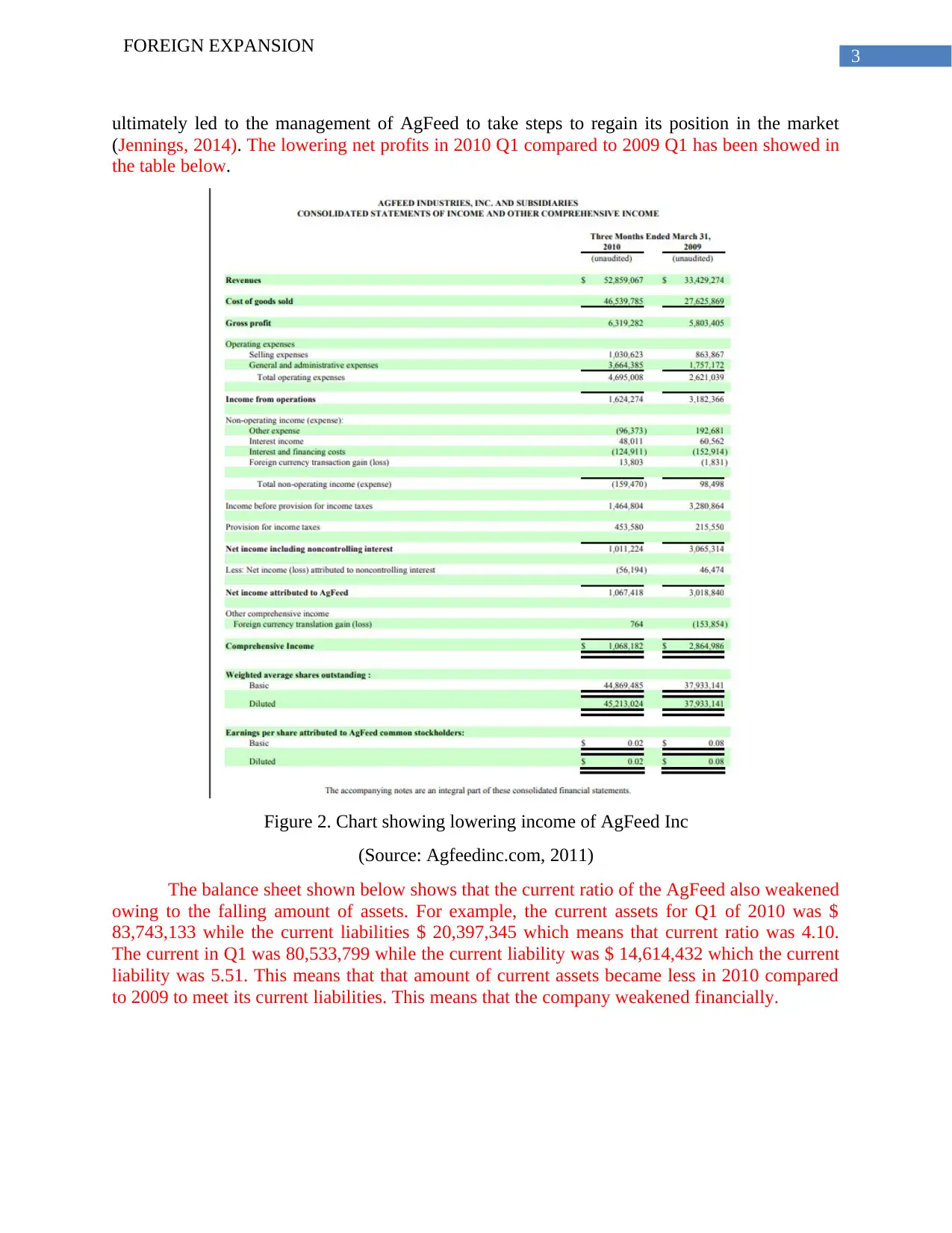
3
FOREIGN EXPANSION
ultimately led to the management of AgFeed to take steps to regain its position in the market
(Jennings, 2014). The lowering net profits in 2010 Q1 compared to 2009 Q1 has been showed in
the table below.
Figure 2. Chart showing lowering income of AgFeed Inc
(Source: Agfeedinc.com, 2011)
The balance sheet shown below shows that the current ratio of the AgFeed also weakened
owing to the falling amount of assets. For example, the current assets for Q1 of 2010 was $
83,743,133 while the current liabilities $ 20,397,345 which means that current ratio was 4.10.
The current in Q1 was 80,533,799 while the current liability was $ 14,614,432 which the current
liability was 5.51. This means that that amount of current assets became less in 2010 compared
to 2009 to meet its current liabilities. This means that the company weakened financially.
FOREIGN EXPANSION
ultimately led to the management of AgFeed to take steps to regain its position in the market
(Jennings, 2014). The lowering net profits in 2010 Q1 compared to 2009 Q1 has been showed in
the table below.
Figure 2. Chart showing lowering income of AgFeed Inc
(Source: Agfeedinc.com, 2011)
The balance sheet shown below shows that the current ratio of the AgFeed also weakened
owing to the falling amount of assets. For example, the current assets for Q1 of 2010 was $
83,743,133 while the current liabilities $ 20,397,345 which means that current ratio was 4.10.
The current in Q1 was 80,533,799 while the current liability was $ 14,614,432 which the current
liability was 5.51. This means that that amount of current assets became less in 2010 compared
to 2009 to meet its current liabilities. This means that the company weakened financially.
Paraphrase This Document
Need a fresh take? Get an instant paraphrase of this document with our AI Paraphraser
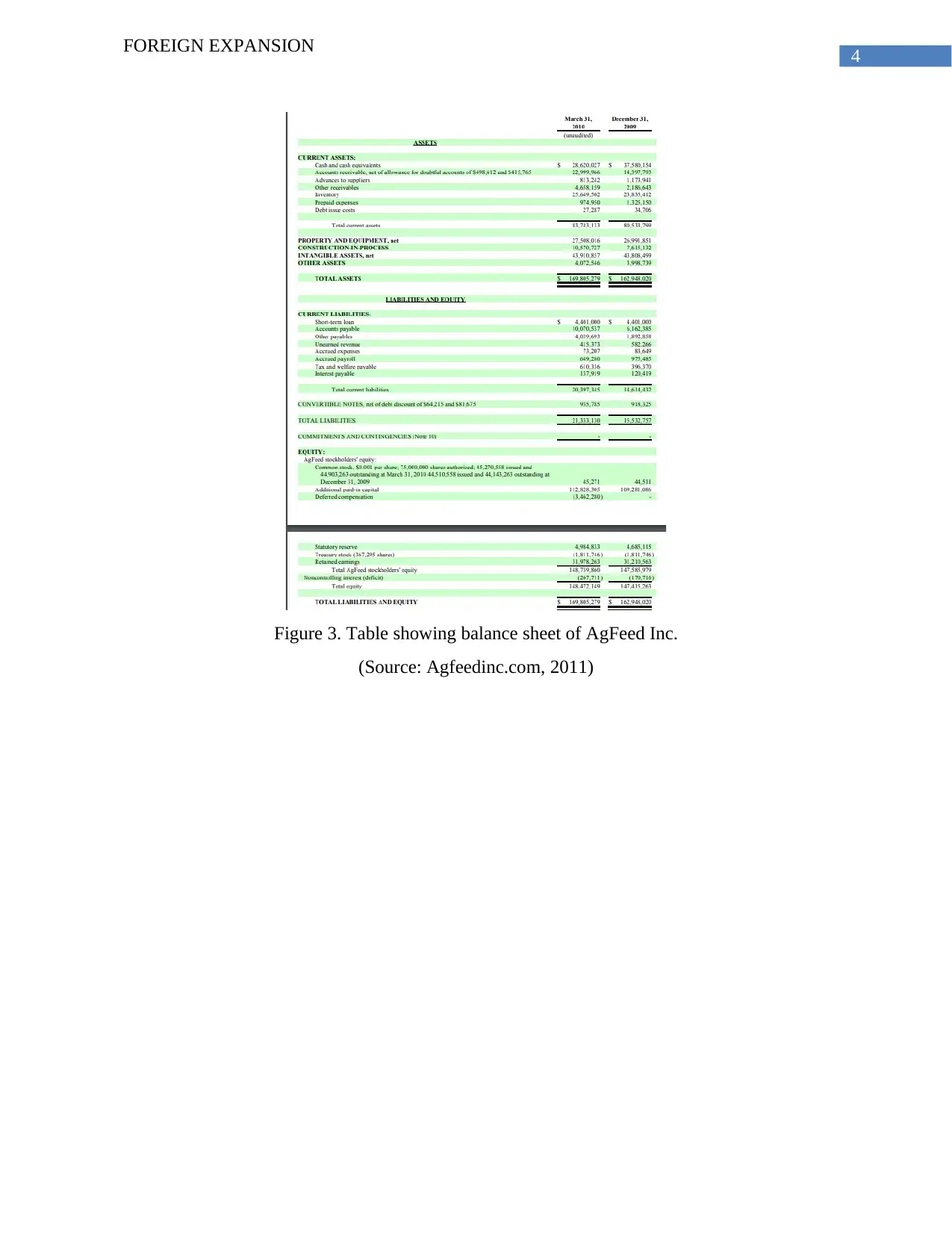
4
FOREIGN EXPANSION
Figure 3. Table showing balance sheet of AgFeed Inc.
(Source: Agfeedinc.com, 2011)
FOREIGN EXPANSION
Figure 3. Table showing balance sheet of AgFeed Inc.
(Source: Agfeedinc.com, 2011)
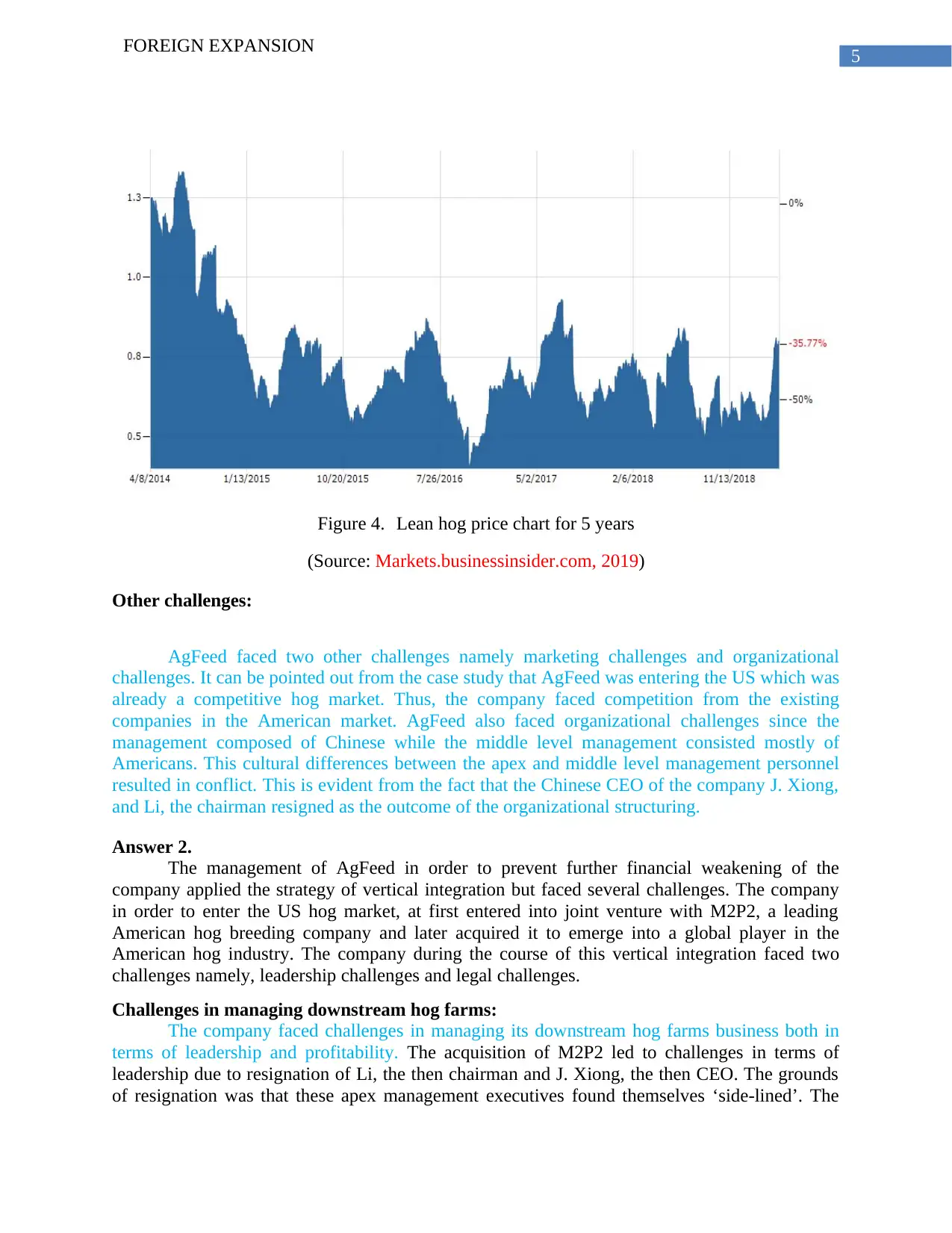
5
FOREIGN EXPANSION
Figure 4. Lean hog price chart for 5 years
(Source: Markets.businessinsider.com, 2019)
Other challenges:
AgFeed faced two other challenges namely marketing challenges and organizational
challenges. It can be pointed out from the case study that AgFeed was entering the US which was
already a competitive hog market. Thus, the company faced competition from the existing
companies in the American market. AgFeed also faced organizational challenges since the
management composed of Chinese while the middle level management consisted mostly of
Americans. This cultural differences between the apex and middle level management personnel
resulted in conflict. This is evident from the fact that the Chinese CEO of the company J. Xiong,
and Li, the chairman resigned as the outcome of the organizational structuring.
Answer 2.
The management of AgFeed in order to prevent further financial weakening of the
company applied the strategy of vertical integration but faced several challenges. The company
in order to enter the US hog market, at first entered into joint venture with M2P2, a leading
American hog breeding company and later acquired it to emerge into a global player in the
American hog industry. The company during the course of this vertical integration faced two
challenges namely, leadership challenges and legal challenges.
Challenges in managing downstream hog farms:
The company faced challenges in managing its downstream hog farms business both in
terms of leadership and profitability. The acquisition of M2P2 led to challenges in terms of
leadership due to resignation of Li, the then chairman and J. Xiong, the then CEO. The grounds
of resignation was that these apex management executives found themselves ‘side-lined’. The
FOREIGN EXPANSION
Figure 4. Lean hog price chart for 5 years
(Source: Markets.businessinsider.com, 2019)
Other challenges:
AgFeed faced two other challenges namely marketing challenges and organizational
challenges. It can be pointed out from the case study that AgFeed was entering the US which was
already a competitive hog market. Thus, the company faced competition from the existing
companies in the American market. AgFeed also faced organizational challenges since the
management composed of Chinese while the middle level management consisted mostly of
Americans. This cultural differences between the apex and middle level management personnel
resulted in conflict. This is evident from the fact that the Chinese CEO of the company J. Xiong,
and Li, the chairman resigned as the outcome of the organizational structuring.
Answer 2.
The management of AgFeed in order to prevent further financial weakening of the
company applied the strategy of vertical integration but faced several challenges. The company
in order to enter the US hog market, at first entered into joint venture with M2P2, a leading
American hog breeding company and later acquired it to emerge into a global player in the
American hog industry. The company during the course of this vertical integration faced two
challenges namely, leadership challenges and legal challenges.
Challenges in managing downstream hog farms:
The company faced challenges in managing its downstream hog farms business both in
terms of leadership and profitability. The acquisition of M2P2 led to challenges in terms of
leadership due to resignation of Li, the then chairman and J. Xiong, the then CEO. The grounds
of resignation was that these apex management executives found themselves ‘side-lined’. The
⊘ This is a preview!⊘
Do you want full access?
Subscribe today to unlock all pages.

Trusted by 1+ million students worldwide
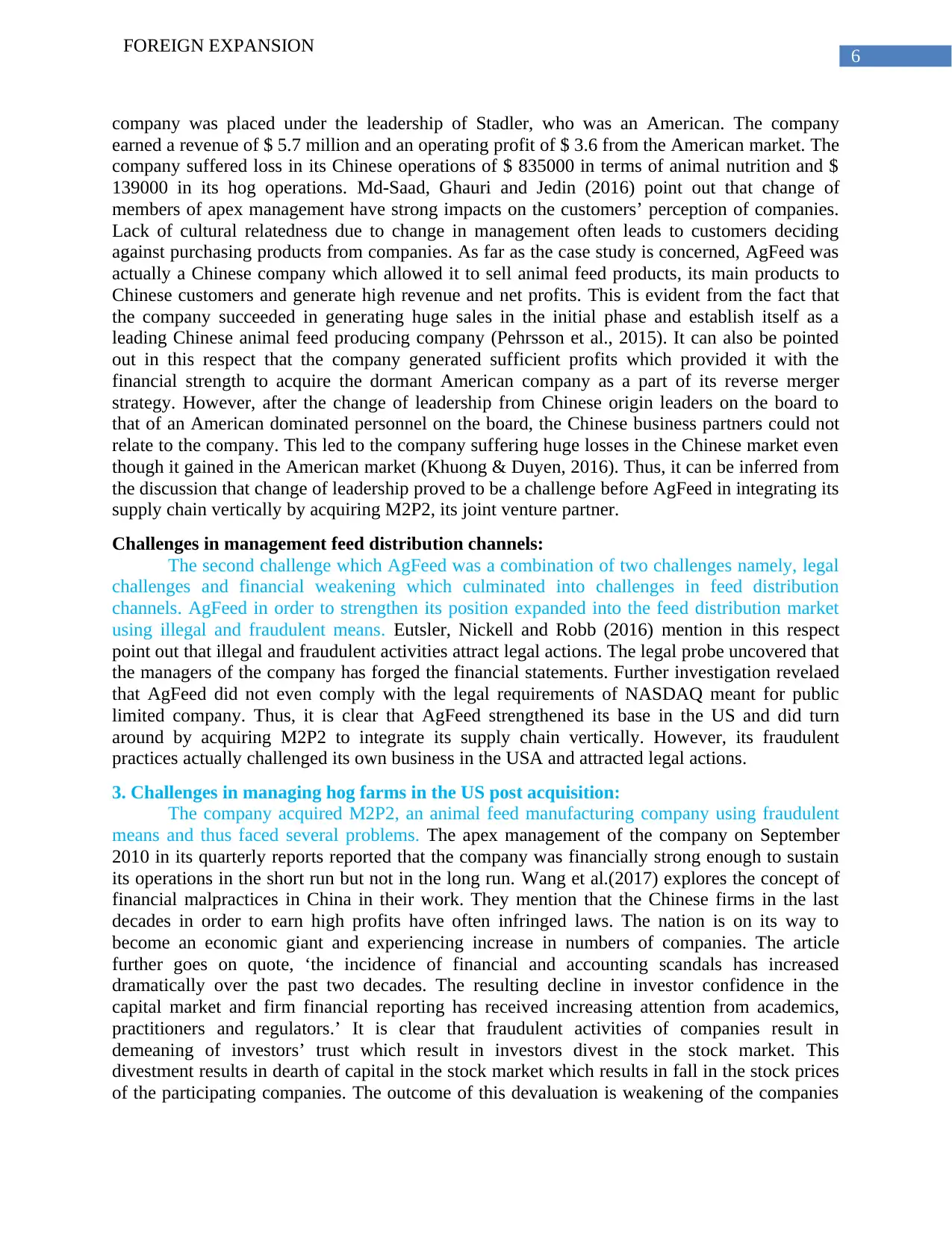
6
FOREIGN EXPANSION
company was placed under the leadership of Stadler, who was an American. The company
earned a revenue of $ 5.7 million and an operating profit of $ 3.6 from the American market. The
company suffered loss in its Chinese operations of $ 835000 in terms of animal nutrition and $
139000 in its hog operations. Md-Saad, Ghauri and Jedin (2016) point out that change of
members of apex management have strong impacts on the customers’ perception of companies.
Lack of cultural relatedness due to change in management often leads to customers deciding
against purchasing products from companies. As far as the case study is concerned, AgFeed was
actually a Chinese company which allowed it to sell animal feed products, its main products to
Chinese customers and generate high revenue and net profits. This is evident from the fact that
the company succeeded in generating huge sales in the initial phase and establish itself as a
leading Chinese animal feed producing company (Pehrsson et al., 2015). It can also be pointed
out in this respect that the company generated sufficient profits which provided it with the
financial strength to acquire the dormant American company as a part of its reverse merger
strategy. However, after the change of leadership from Chinese origin leaders on the board to
that of an American dominated personnel on the board, the Chinese business partners could not
relate to the company. This led to the company suffering huge losses in the Chinese market even
though it gained in the American market (Khuong & Duyen, 2016). Thus, it can be inferred from
the discussion that change of leadership proved to be a challenge before AgFeed in integrating its
supply chain vertically by acquiring M2P2, its joint venture partner.
Challenges in management feed distribution channels:
The second challenge which AgFeed was a combination of two challenges namely, legal
challenges and financial weakening which culminated into challenges in feed distribution
channels. AgFeed in order to strengthen its position expanded into the feed distribution market
using illegal and fraudulent means. Eutsler, Nickell and Robb (2016) mention in this respect
point out that illegal and fraudulent activities attract legal actions. The legal probe uncovered that
the managers of the company has forged the financial statements. Further investigation revelaed
that AgFeed did not even comply with the legal requirements of NASDAQ meant for public
limited company. Thus, it is clear that AgFeed strengthened its base in the US and did turn
around by acquiring M2P2 to integrate its supply chain vertically. However, its fraudulent
practices actually challenged its own business in the USA and attracted legal actions.
3. Challenges in managing hog farms in the US post acquisition:
The company acquired M2P2, an animal feed manufacturing company using fraudulent
means and thus faced several problems. The apex management of the company on September
2010 in its quarterly reports reported that the company was financially strong enough to sustain
its operations in the short run but not in the long run. Wang et al.(2017) explores the concept of
financial malpractices in China in their work. They mention that the Chinese firms in the last
decades in order to earn high profits have often infringed laws. The nation is on its way to
become an economic giant and experiencing increase in numbers of companies. The article
further goes on quote, ‘the incidence of financial and accounting scandals has increased
dramatically over the past two decades. The resulting decline in investor confidence in the
capital market and firm financial reporting has received increasing attention from academics,
practitioners and regulators.’ It is clear that fraudulent activities of companies result in
demeaning of investors’ trust which result in investors divest in the stock market. This
divestment results in dearth of capital in the stock market which results in fall in the stock prices
of the participating companies. The outcome of this devaluation is weakening of the companies
FOREIGN EXPANSION
company was placed under the leadership of Stadler, who was an American. The company
earned a revenue of $ 5.7 million and an operating profit of $ 3.6 from the American market. The
company suffered loss in its Chinese operations of $ 835000 in terms of animal nutrition and $
139000 in its hog operations. Md-Saad, Ghauri and Jedin (2016) point out that change of
members of apex management have strong impacts on the customers’ perception of companies.
Lack of cultural relatedness due to change in management often leads to customers deciding
against purchasing products from companies. As far as the case study is concerned, AgFeed was
actually a Chinese company which allowed it to sell animal feed products, its main products to
Chinese customers and generate high revenue and net profits. This is evident from the fact that
the company succeeded in generating huge sales in the initial phase and establish itself as a
leading Chinese animal feed producing company (Pehrsson et al., 2015). It can also be pointed
out in this respect that the company generated sufficient profits which provided it with the
financial strength to acquire the dormant American company as a part of its reverse merger
strategy. However, after the change of leadership from Chinese origin leaders on the board to
that of an American dominated personnel on the board, the Chinese business partners could not
relate to the company. This led to the company suffering huge losses in the Chinese market even
though it gained in the American market (Khuong & Duyen, 2016). Thus, it can be inferred from
the discussion that change of leadership proved to be a challenge before AgFeed in integrating its
supply chain vertically by acquiring M2P2, its joint venture partner.
Challenges in management feed distribution channels:
The second challenge which AgFeed was a combination of two challenges namely, legal
challenges and financial weakening which culminated into challenges in feed distribution
channels. AgFeed in order to strengthen its position expanded into the feed distribution market
using illegal and fraudulent means. Eutsler, Nickell and Robb (2016) mention in this respect
point out that illegal and fraudulent activities attract legal actions. The legal probe uncovered that
the managers of the company has forged the financial statements. Further investigation revelaed
that AgFeed did not even comply with the legal requirements of NASDAQ meant for public
limited company. Thus, it is clear that AgFeed strengthened its base in the US and did turn
around by acquiring M2P2 to integrate its supply chain vertically. However, its fraudulent
practices actually challenged its own business in the USA and attracted legal actions.
3. Challenges in managing hog farms in the US post acquisition:
The company acquired M2P2, an animal feed manufacturing company using fraudulent
means and thus faced several problems. The apex management of the company on September
2010 in its quarterly reports reported that the company was financially strong enough to sustain
its operations in the short run but not in the long run. Wang et al.(2017) explores the concept of
financial malpractices in China in their work. They mention that the Chinese firms in the last
decades in order to earn high profits have often infringed laws. The nation is on its way to
become an economic giant and experiencing increase in numbers of companies. The article
further goes on quote, ‘the incidence of financial and accounting scandals has increased
dramatically over the past two decades. The resulting decline in investor confidence in the
capital market and firm financial reporting has received increasing attention from academics,
practitioners and regulators.’ It is clear that fraudulent activities of companies result in
demeaning of investors’ trust which result in investors divest in the stock market. This
divestment results in dearth of capital in the stock market which results in fall in the stock prices
of the participating companies. The outcome of this devaluation is weakening of the companies
Paraphrase This Document
Need a fresh take? Get an instant paraphrase of this document with our AI Paraphraser
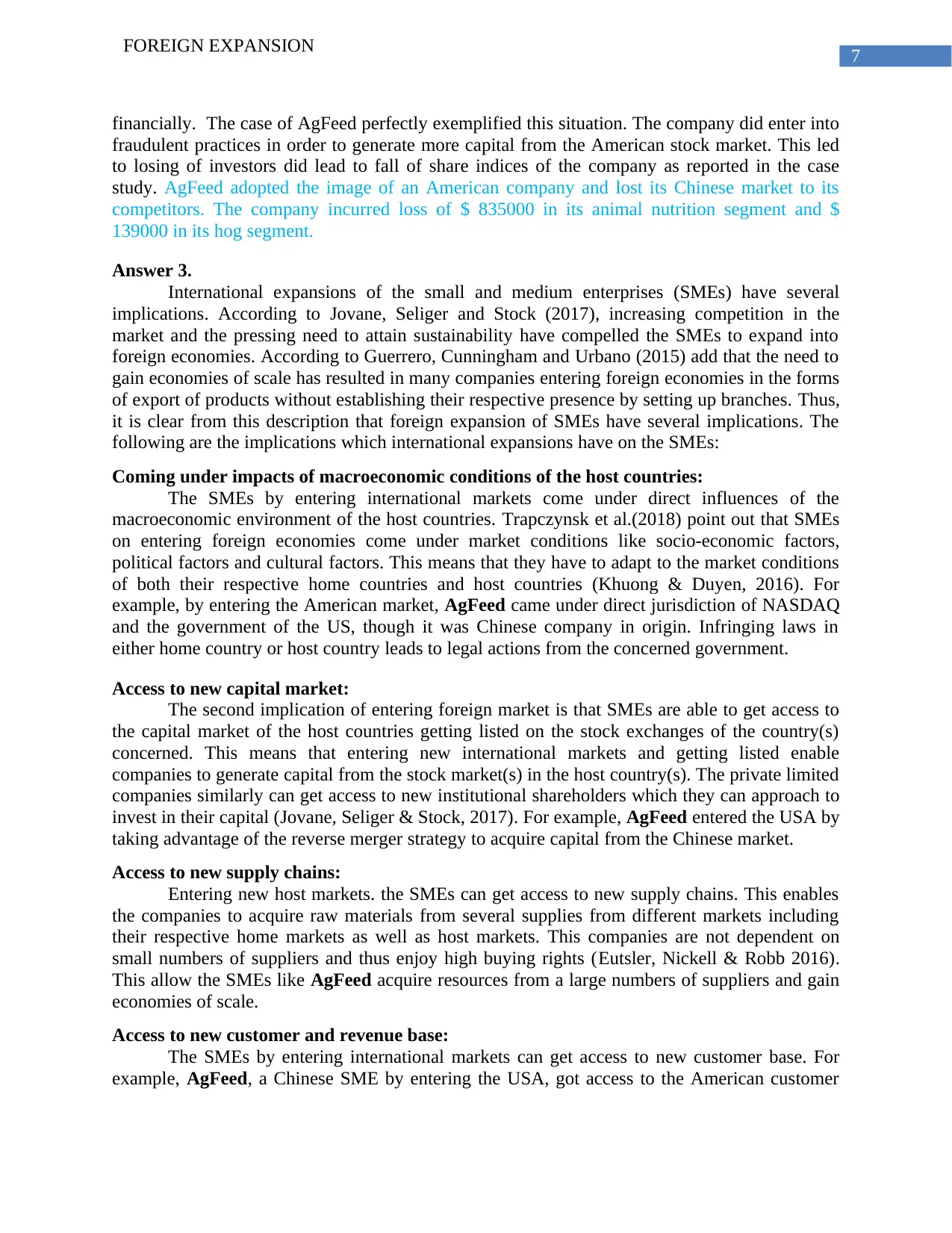
7
FOREIGN EXPANSION
financially. The case of AgFeed perfectly exemplified this situation. The company did enter into
fraudulent practices in order to generate more capital from the American stock market. This led
to losing of investors did lead to fall of share indices of the company as reported in the case
study. AgFeed adopted the image of an American company and lost its Chinese market to its
competitors. The company incurred loss of $ 835000 in its animal nutrition segment and $
139000 in its hog segment.
Answer 3.
International expansions of the small and medium enterprises (SMEs) have several
implications. According to Jovane, Seliger and Stock (2017), increasing competition in the
market and the pressing need to attain sustainability have compelled the SMEs to expand into
foreign economies. According to Guerrero, Cunningham and Urbano (2015) add that the need to
gain economies of scale has resulted in many companies entering foreign economies in the forms
of export of products without establishing their respective presence by setting up branches. Thus,
it is clear from this description that foreign expansion of SMEs have several implications. The
following are the implications which international expansions have on the SMEs:
Coming under impacts of macroeconomic conditions of the host countries:
The SMEs by entering international markets come under direct influences of the
macroeconomic environment of the host countries. Trapczynsk et al.(2018) point out that SMEs
on entering foreign economies come under market conditions like socio-economic factors,
political factors and cultural factors. This means that they have to adapt to the market conditions
of both their respective home countries and host countries (Khuong & Duyen, 2016). For
example, by entering the American market, AgFeed came under direct jurisdiction of NASDAQ
and the government of the US, though it was Chinese company in origin. Infringing laws in
either home country or host country leads to legal actions from the concerned government.
Access to new capital market:
The second implication of entering foreign market is that SMEs are able to get access to
the capital market of the host countries getting listed on the stock exchanges of the country(s)
concerned. This means that entering new international markets and getting listed enable
companies to generate capital from the stock market(s) in the host country(s). The private limited
companies similarly can get access to new institutional shareholders which they can approach to
invest in their capital (Jovane, Seliger & Stock, 2017). For example, AgFeed entered the USA by
taking advantage of the reverse merger strategy to acquire capital from the Chinese market.
Access to new supply chains:
Entering new host markets. the SMEs can get access to new supply chains. This enables
the companies to acquire raw materials from several supplies from different markets including
their respective home markets as well as host markets. This companies are not dependent on
small numbers of suppliers and thus enjoy high buying rights (Eutsler, Nickell & Robb 2016).
This allow the SMEs like AgFeed acquire resources from a large numbers of suppliers and gain
economies of scale.
Access to new customer and revenue base:
The SMEs by entering international markets can get access to new customer base. For
example, AgFeed, a Chinese SME by entering the USA, got access to the American customer
FOREIGN EXPANSION
financially. The case of AgFeed perfectly exemplified this situation. The company did enter into
fraudulent practices in order to generate more capital from the American stock market. This led
to losing of investors did lead to fall of share indices of the company as reported in the case
study. AgFeed adopted the image of an American company and lost its Chinese market to its
competitors. The company incurred loss of $ 835000 in its animal nutrition segment and $
139000 in its hog segment.
Answer 3.
International expansions of the small and medium enterprises (SMEs) have several
implications. According to Jovane, Seliger and Stock (2017), increasing competition in the
market and the pressing need to attain sustainability have compelled the SMEs to expand into
foreign economies. According to Guerrero, Cunningham and Urbano (2015) add that the need to
gain economies of scale has resulted in many companies entering foreign economies in the forms
of export of products without establishing their respective presence by setting up branches. Thus,
it is clear from this description that foreign expansion of SMEs have several implications. The
following are the implications which international expansions have on the SMEs:
Coming under impacts of macroeconomic conditions of the host countries:
The SMEs by entering international markets come under direct influences of the
macroeconomic environment of the host countries. Trapczynsk et al.(2018) point out that SMEs
on entering foreign economies come under market conditions like socio-economic factors,
political factors and cultural factors. This means that they have to adapt to the market conditions
of both their respective home countries and host countries (Khuong & Duyen, 2016). For
example, by entering the American market, AgFeed came under direct jurisdiction of NASDAQ
and the government of the US, though it was Chinese company in origin. Infringing laws in
either home country or host country leads to legal actions from the concerned government.
Access to new capital market:
The second implication of entering foreign market is that SMEs are able to get access to
the capital market of the host countries getting listed on the stock exchanges of the country(s)
concerned. This means that entering new international markets and getting listed enable
companies to generate capital from the stock market(s) in the host country(s). The private limited
companies similarly can get access to new institutional shareholders which they can approach to
invest in their capital (Jovane, Seliger & Stock, 2017). For example, AgFeed entered the USA by
taking advantage of the reverse merger strategy to acquire capital from the Chinese market.
Access to new supply chains:
Entering new host markets. the SMEs can get access to new supply chains. This enables
the companies to acquire raw materials from several supplies from different markets including
their respective home markets as well as host markets. This companies are not dependent on
small numbers of suppliers and thus enjoy high buying rights (Eutsler, Nickell & Robb 2016).
This allow the SMEs like AgFeed acquire resources from a large numbers of suppliers and gain
economies of scale.
Access to new customer and revenue base:
The SMEs by entering international markets can get access to new customer base. For
example, AgFeed, a Chinese SME by entering the USA, got access to the American customer

8
FOREIGN EXPANSION
base in the feed industry. Thus, it is evident that SMes that by entering foreign markets are able
get access to new customer base which boosts their revenue generation.
Intense competition:
The SMEs on entering into international markets are encountered with competition from
existing firms. Awa, Ojiabo & Emecheta (2015) point out that entering new countries results in
firms coming in direct competition with the resident competitors of a particular base. Moreover,
the firms have to compete with the non-resident companies which have already established
themselves in the markets. It can pointed out that this implication unlike other implications is a
threat to the companies. For example, on entering the US animal feed and hog market, AgFeed
had to compete with the other animal feed companies already in the US.
Talent acquisitions:
The SMEs on entering new host countries are able to acquire talents from the host
countries to lower their operational costs. This acquisition of foreign talents enable the
companies to bring about innovation in the organizational operations. The new employees add to
the knowledge capital of the SMEs which enhances their efficiency (Khuong & Duyen, 2016).
Need to adapt to cultures of the host countries as well as home countries:
The SMEs on entering foreign countries have to adapt to the cultures of the host nations
and home countries. This requires the companies to integrate their global and local strategies to
adapt to the cultural backgrounds of different customer base (Jovane, Seliger & Stock, 2017).
Finally, it can be concluded that the company should from strategies to counteract markets which
it would face in the foreign markets.
FOREIGN EXPANSION
base in the feed industry. Thus, it is evident that SMes that by entering foreign markets are able
get access to new customer base which boosts their revenue generation.
Intense competition:
The SMEs on entering into international markets are encountered with competition from
existing firms. Awa, Ojiabo & Emecheta (2015) point out that entering new countries results in
firms coming in direct competition with the resident competitors of a particular base. Moreover,
the firms have to compete with the non-resident companies which have already established
themselves in the markets. It can pointed out that this implication unlike other implications is a
threat to the companies. For example, on entering the US animal feed and hog market, AgFeed
had to compete with the other animal feed companies already in the US.
Talent acquisitions:
The SMEs on entering new host countries are able to acquire talents from the host
countries to lower their operational costs. This acquisition of foreign talents enable the
companies to bring about innovation in the organizational operations. The new employees add to
the knowledge capital of the SMEs which enhances their efficiency (Khuong & Duyen, 2016).
Need to adapt to cultures of the host countries as well as home countries:
The SMEs on entering foreign countries have to adapt to the cultures of the host nations
and home countries. This requires the companies to integrate their global and local strategies to
adapt to the cultural backgrounds of different customer base (Jovane, Seliger & Stock, 2017).
Finally, it can be concluded that the company should from strategies to counteract markets which
it would face in the foreign markets.
⊘ This is a preview!⊘
Do you want full access?
Subscribe today to unlock all pages.

Trusted by 1+ million students worldwide
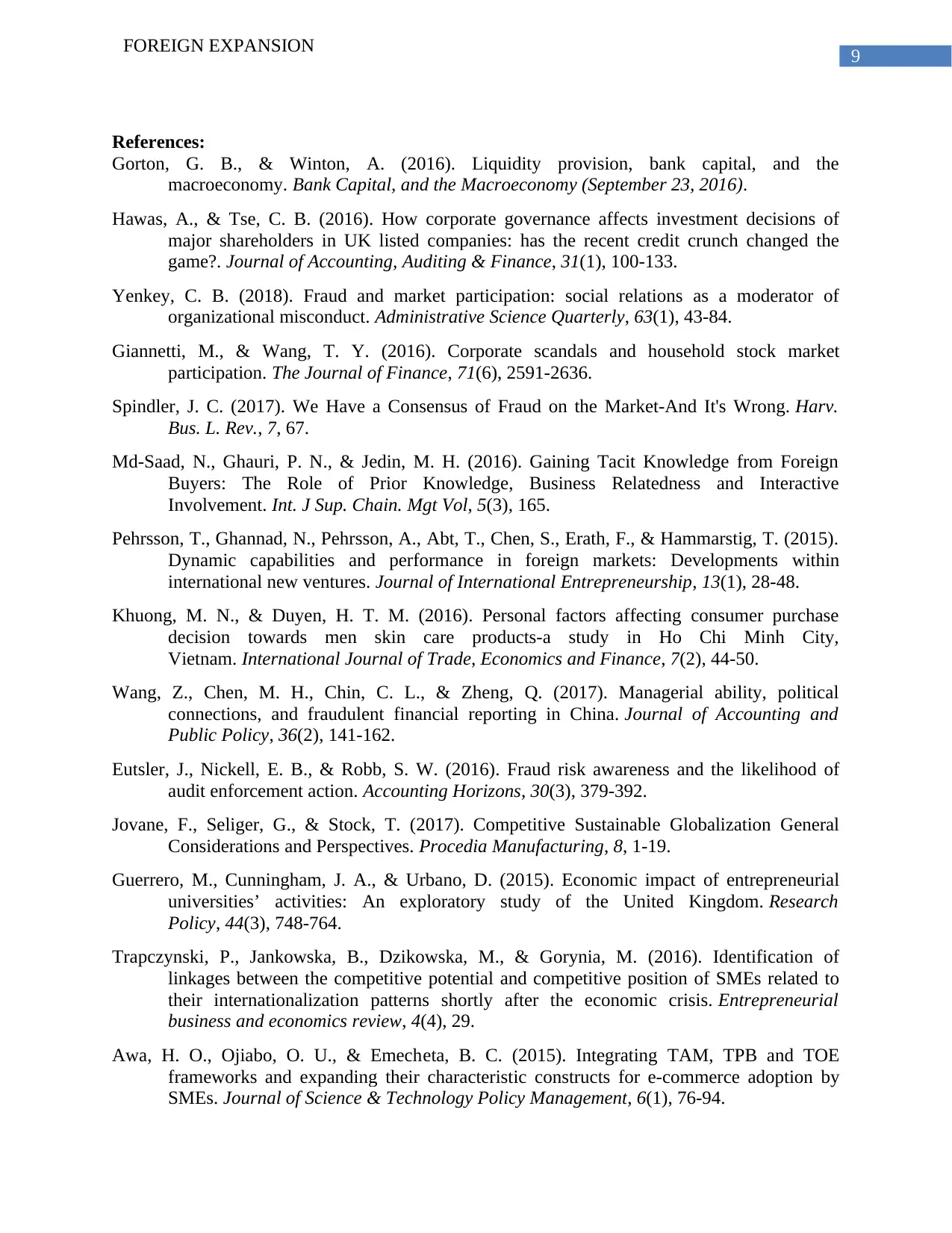
9
FOREIGN EXPANSION
References:
Gorton, G. B., & Winton, A. (2016). Liquidity provision, bank capital, and the
macroeconomy. Bank Capital, and the Macroeconomy (September 23, 2016).
Hawas, A., & Tse, C. B. (2016). How corporate governance affects investment decisions of
major shareholders in UK listed companies: has the recent credit crunch changed the
game?. Journal of Accounting, Auditing & Finance, 31(1), 100-133.
Yenkey, C. B. (2018). Fraud and market participation: social relations as a moderator of
organizational misconduct. Administrative Science Quarterly, 63(1), 43-84.
Giannetti, M., & Wang, T. Y. (2016). Corporate scandals and household stock market
participation. The Journal of Finance, 71(6), 2591-2636.
Spindler, J. C. (2017). We Have a Consensus of Fraud on the Market-And It's Wrong. Harv.
Bus. L. Rev., 7, 67.
Md-Saad, N., Ghauri, P. N., & Jedin, M. H. (2016). Gaining Tacit Knowledge from Foreign
Buyers: The Role of Prior Knowledge, Business Relatedness and Interactive
Involvement. Int. J Sup. Chain. Mgt Vol, 5(3), 165.
Pehrsson, T., Ghannad, N., Pehrsson, A., Abt, T., Chen, S., Erath, F., & Hammarstig, T. (2015).
Dynamic capabilities and performance in foreign markets: Developments within
international new ventures. Journal of International Entrepreneurship, 13(1), 28-48.
Khuong, M. N., & Duyen, H. T. M. (2016). Personal factors affecting consumer purchase
decision towards men skin care products-a study in Ho Chi Minh City,
Vietnam. International Journal of Trade, Economics and Finance, 7(2), 44-50.
Wang, Z., Chen, M. H., Chin, C. L., & Zheng, Q. (2017). Managerial ability, political
connections, and fraudulent financial reporting in China. Journal of Accounting and
Public Policy, 36(2), 141-162.
Eutsler, J., Nickell, E. B., & Robb, S. W. (2016). Fraud risk awareness and the likelihood of
audit enforcement action. Accounting Horizons, 30(3), 379-392.
Jovane, F., Seliger, G., & Stock, T. (2017). Competitive Sustainable Globalization General
Considerations and Perspectives. Procedia Manufacturing, 8, 1-19.
Guerrero, M., Cunningham, J. A., & Urbano, D. (2015). Economic impact of entrepreneurial
universities’ activities: An exploratory study of the United Kingdom. Research
Policy, 44(3), 748-764.
Trapczynski, P., Jankowska, B., Dzikowska, M., & Gorynia, M. (2016). Identification of
linkages between the competitive potential and competitive position of SMEs related to
their internationalization patterns shortly after the economic crisis. Entrepreneurial
business and economics review, 4(4), 29.
Awa, H. O., Ojiabo, O. U., & Emecheta, B. C. (2015). Integrating TAM, TPB and TOE
frameworks and expanding their characteristic constructs for e-commerce adoption by
SMEs. Journal of Science & Technology Policy Management, 6(1), 76-94.
FOREIGN EXPANSION
References:
Gorton, G. B., & Winton, A. (2016). Liquidity provision, bank capital, and the
macroeconomy. Bank Capital, and the Macroeconomy (September 23, 2016).
Hawas, A., & Tse, C. B. (2016). How corporate governance affects investment decisions of
major shareholders in UK listed companies: has the recent credit crunch changed the
game?. Journal of Accounting, Auditing & Finance, 31(1), 100-133.
Yenkey, C. B. (2018). Fraud and market participation: social relations as a moderator of
organizational misconduct. Administrative Science Quarterly, 63(1), 43-84.
Giannetti, M., & Wang, T. Y. (2016). Corporate scandals and household stock market
participation. The Journal of Finance, 71(6), 2591-2636.
Spindler, J. C. (2017). We Have a Consensus of Fraud on the Market-And It's Wrong. Harv.
Bus. L. Rev., 7, 67.
Md-Saad, N., Ghauri, P. N., & Jedin, M. H. (2016). Gaining Tacit Knowledge from Foreign
Buyers: The Role of Prior Knowledge, Business Relatedness and Interactive
Involvement. Int. J Sup. Chain. Mgt Vol, 5(3), 165.
Pehrsson, T., Ghannad, N., Pehrsson, A., Abt, T., Chen, S., Erath, F., & Hammarstig, T. (2015).
Dynamic capabilities and performance in foreign markets: Developments within
international new ventures. Journal of International Entrepreneurship, 13(1), 28-48.
Khuong, M. N., & Duyen, H. T. M. (2016). Personal factors affecting consumer purchase
decision towards men skin care products-a study in Ho Chi Minh City,
Vietnam. International Journal of Trade, Economics and Finance, 7(2), 44-50.
Wang, Z., Chen, M. H., Chin, C. L., & Zheng, Q. (2017). Managerial ability, political
connections, and fraudulent financial reporting in China. Journal of Accounting and
Public Policy, 36(2), 141-162.
Eutsler, J., Nickell, E. B., & Robb, S. W. (2016). Fraud risk awareness and the likelihood of
audit enforcement action. Accounting Horizons, 30(3), 379-392.
Jovane, F., Seliger, G., & Stock, T. (2017). Competitive Sustainable Globalization General
Considerations and Perspectives. Procedia Manufacturing, 8, 1-19.
Guerrero, M., Cunningham, J. A., & Urbano, D. (2015). Economic impact of entrepreneurial
universities’ activities: An exploratory study of the United Kingdom. Research
Policy, 44(3), 748-764.
Trapczynski, P., Jankowska, B., Dzikowska, M., & Gorynia, M. (2016). Identification of
linkages between the competitive potential and competitive position of SMEs related to
their internationalization patterns shortly after the economic crisis. Entrepreneurial
business and economics review, 4(4), 29.
Awa, H. O., Ojiabo, O. U., & Emecheta, B. C. (2015). Integrating TAM, TPB and TOE
frameworks and expanding their characteristic constructs for e-commerce adoption by
SMEs. Journal of Science & Technology Policy Management, 6(1), 76-94.
Paraphrase This Document
Need a fresh take? Get an instant paraphrase of this document with our AI Paraphraser

10
FOREIGN EXPANSION
Jennings, M. M. (2014). Business: Its legal, ethical, and global environment. Nelson Education.
Agfeedinc.com. (2011). Retrieved from
http://www.agfeedinc.com/system/resources/0000/0032/2010-
1_Agfeed_Form_10Q_March_31__2010-1.pdf
Nyse.com. (2019). Retrieved from https://www.nyse.com/listings/international-listings
Markets.businessinsider.com. (2019). Retrieved from
https://markets.businessinsider.com/commodities/lean-hog-price
Ferguson, J., Power, D., Stevenson, L., & Collison, D. (2017, September). Shareholder
protection, income inequality and social health: a proposed research agenda.
In Accounting Forum (Vol. 41, No. 3, pp. 253-265). Taylor & Francis.
FOREIGN EXPANSION
Jennings, M. M. (2014). Business: Its legal, ethical, and global environment. Nelson Education.
Agfeedinc.com. (2011). Retrieved from
http://www.agfeedinc.com/system/resources/0000/0032/2010-
1_Agfeed_Form_10Q_March_31__2010-1.pdf
Nyse.com. (2019). Retrieved from https://www.nyse.com/listings/international-listings
Markets.businessinsider.com. (2019). Retrieved from
https://markets.businessinsider.com/commodities/lean-hog-price
Ferguson, J., Power, D., Stevenson, L., & Collison, D. (2017, September). Shareholder
protection, income inequality and social health: a proposed research agenda.
In Accounting Forum (Vol. 41, No. 3, pp. 253-265). Taylor & Francis.
1 out of 11
Related Documents
Your All-in-One AI-Powered Toolkit for Academic Success.
+13062052269
info@desklib.com
Available 24*7 on WhatsApp / Email
![[object Object]](/_next/static/media/star-bottom.7253800d.svg)
Unlock your academic potential
Copyright © 2020–2025 A2Z Services. All Rights Reserved. Developed and managed by ZUCOL.





